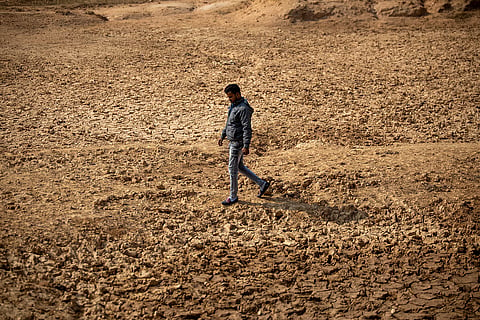

Deoria in eastern Uttar Pradesh has emerged as the driest district in the country this monsoon, with rainfall 87 per cent below normal levels, according to official data.
The Purvanchal region of Uttar Pradesh has been receiving steadily less rain over the past few years, but this year Deoria saw historically low levels. By September 25, 2025 the district had received only 97.2 millimetres (mm) of rain compared with the seasonal average of 759.4 mm.
Over the 16 weeks of the monsoon season this year, Deoria experienced a large rainfall deficit every single week. In the first eight, the deficit was between 90 per cent and 100 per cent, while in the remaining it stood at 80-90 per cent.
Mandhata Singh, chief scientist at the Krishi Vigyan Kendra, Deoria, said he had never seen such low rainfall in the district. He attributed the shortage to climate change, noting that the trend had been evident for the past three years.
Farmers’ organisations and opposition parties have demanded that Deoria be declared drought-affected, but the administration has yet to act. One possible reason is that most agricultural land in the district is irrigated, reducing the immediate impact of rainfall failure.
Deoria also recorded a 43 per cent monsoon deficit in 2024 and 46 per cent in 2023, although rainfall was above average between 2020 and 2022.
According to the India Meteorological Department (IMD), the 42 districts of eastern Uttar Pradesh received 16 per cent less rainfall than normal this monsoon, with only Deoria and neighbouring Kushinagar falling into the “large deficit” category. Kushinagar reported a 64 per cent deficit.
The IMD’s 2024 monsoon report had classified Kushinagar as facing severe dry conditions, while Deoria, Chandauli, Faizabad, Fatehpur, Gautam Buddha Nagar, Panchsheel Nagar, Jaunpur, Jyotiba Phule Nagar, Mau, Mirzapur, Sitapur, Unnao, Sant Ravidas Nagar and Amethi were all listed as facing moderately dry conditions.
This year, 21 of eastern Uttar Pradesh’s 33 districts, almost half, have been classified as rainfall-deficit areas, with shortages ranging from 20 per cent to 59 per cent.
In contrast, western Uttar Pradesh recorded 12 per cent excess rainfall. Only Pilibhit was listed in the large-deficit category, while five districts were deficit.
Residents say the monsoon has been “bypassing” Purvanchal for several years. Rajkumar Singh, a farmer from Padrauna in Kushinagar, told Down To Earth that his rice crop had suffered from the lack of rain despite widespread irrigation. “Although most of the land is irrigated, the lack of monsoon rain is causing a 40-60 per cent fall in production,” he said.
He added: “We monitor the progress of the southwest monsoon every year. We’re noticing that it is bypassing Purvanchal and moving forward.”
The IMD’s district-level data supports this. In 2025, Azamgarh recorded 40 per cent less rainfall, Ballia 21 per cent, Basti 22 per cent, Bhadohi 32 per cent, Chandauli 39 per cent, Ghazipur 24 per cent, Gorakhpur 43 per cent, Jaunpur 44 per cent, Maharajganj 20 per cent, Mau 53 per cent, Sant Kabir Nagar 53 per cent and Siddharth Nagar 33 per cent.
Singh also believes the monsoon has shifted away from Purvanchal. He said neighbouring districts in Bihar were experiencing similar patterns. While widespread irrigation has prevented severe drought in Deoria, he warned that climate change was reshaping rainfall across the region.